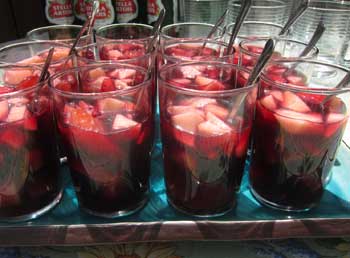 When summer temperatures go up, my appetite goes down. I want less to eat and more to drink. Homemade lemonade with mint is a great favorite. Iced tea in a tall glass filled with cracked ice is a great way to cool down. On a recent trip to Spain, I rediscovered sangria, which might be the best remedy for double and triple digit heat waves.
When summer temperatures go up, my appetite goes down. I want less to eat and more to drink. Homemade lemonade with mint is a great favorite. Iced tea in a tall glass filled with cracked ice is a great way to cool down. On a recent trip to Spain, I rediscovered sangria, which might be the best remedy for double and triple digit heat waves.
In the summer, the Iberia Peninsula bakes under an unforgiving sun. Spaniards long ago learned that the best way to beat back the effects of hot weather is to eat small plates ("tapas") and drink wine flavored with fresh fruit.
When I was served a glass of sangria in a bar in San Sebastián, a small resort town on the coast of Northern Spain, I loved the way fresh fruit added flavor to the wine. Fortified with brandy and sugar, sangria goes well with small sandwiches, salads and snacks.
Visit Spain and you'll see sangria pitchers. Wide at the base, the large pitchers have a spout narrowed at the end. When the pitcher is made, the potter gently pinches the spout to narrow the opening, allowing the wine but not the fruit to enter the glass.
For me, a great advantage of the vegan diet is the focus on what's best, what's fresh and what's in season. Which made me put two and two together and combine my enjoyment of sangria with my love of fresh fruit salads. The result is a wine beverage that carries memories of the fruit but not the fruit itself. Sitting in that small bar, enjoying a relaxed afternoon, I wondered at this exclusion. Why keep the fruit out of the glass?
When peaches, apples, limes and oranges go into a sangria, they are sliced but not peeled. The thought that played around in my head was why not peel the fruit and cut everything into spoon sized pieces? Doing that would allow the wine and fruit to be served together.
Place a dozen on a tray, with an espresso spoon in each glass and your guests will enjoy an appetizer and cocktail in one.
Sangria Fruit Salad
Nothing is better than a great wine that has matured so that its best qualities delight the palate with layers of flavor and a multitude of notes. Using a bottle of quality wine to make sangria is a waste. The same goes for the brandy. Because so many of the flavors will come from other sources, select a drinkable, inexpensive red wine and brandy. Personally, I like Merlot, but the choice is entirely up to you. If you prefer white wine, fumé blanc and chardonnay work well.
Use firm and ripe fruit that is in season. Stone fruit like cherries, peaches and nectarines, grapes, oranges, limes, strawberries, Fuji apples and pears work well.
Cut up and add the fruits just before serving so they don't become soggy by absorbing too much wine.
Serves 4-6
Ingredients:
1 750 ml bottle red wine
1/2 cup brandy
1/4 cup white granulated sugar
Juice of one lemon or lime
3 oranges, preferably Valencia
2 Fuji apples, washed, peeled, cut into quarter sized cubes
2 white nectarines, washed, peeled, cut into quarter sized cubes
6 large strawberries, washed, stems removed
Directions:
In a large pitcher, mix together the wine, brandy, sugar and lemon juice. Chill in the refrigerator.
Using a sharp knife, peel the oranges, removing all the peel together with the rind. Hold the peeled oranges over a bowl to catch all the juice. Cut the orange sections free from the membrane. When all the sections have been removed, squeeze the membrane to capture the last bit of delicious juice.
Just before serving, add the orange sections, orange juice and cut up strawberries, apples and nectarines. Stir well.
Use a ladle to fill glasses with a good amount of the fruit. Top off with the sangria. Place an espresso spoon in each glass.
David Latt is an Emmy-award winning television producer who turns to cooking to alleviate stress. He shares his experiences with food and his favorite recipes on his blog Men Who Like To Cook.

